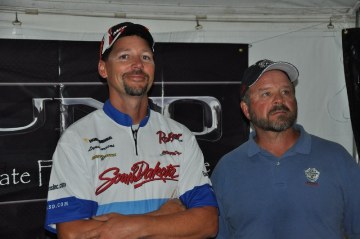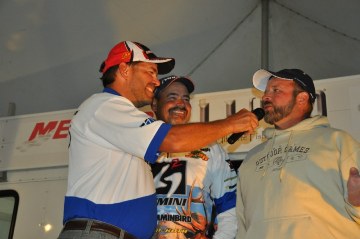Fishing the “Am” Side of a Pro-Am: My Perspective
Sep 7th, 2010 by OutdoorsFIRST
Modified Sep 7th, 2010 at 12:00 AM
It’s been a couple years since being intimately involved in the pro walleye game. That changed at the AIM Championship on Winnie. I elected to fish the “Am” side of the tournament, something I have always wanted to do since originating the concept many years ago.
First, a little history lesson. When Al Lindner asked me to take over the PWT at the Rainy Lake Championship, won by Mark Martin in 1990, I said, “Yes.” My official duties started then and there, and I was busy reviewing and editing the rules on my northern Wisconsin deer stand that November (remember, that year it got to 60 degrees on opening day?).
The PWT was a pro-pro draw in 1990, and again in 1991. At the urging of Mike McClelland to transform the PWT into a pro-am, I researched the concept, watched the issues of the ’91 season unfold, and upon deciding it was indeed the direction necessary, presented my plan to the PWT board of directors, which included In-Fisherman and Cabela’s executives. Reluctantly, they agreed.
The rest is history. One of those very close to Mille Lacs told me that we would never get enough Mille Lacs anglers to sign-up for that event. He was wrong; it filled in less than a week. So did all the others. The amateur concept grew the sport, educated and taught many current-day pro anglers, showed tactics to opinion-leaders who went home to their dealers, fishing clubs and buddies and shared what they learned. Many team tournament players couldn’t wait to try out the new tactics at home.
Walleye gear and techniques were being invented and innovated on tour. With more people (ams) taking part first-hand, word of tournament-tested “stuff” spread far and wide quickly. I heard it week after week what a bargain it was to fish as an amateur. Many were surprised to win prizes – they thought what happened in the boats was reward enough for entering.
I was able to observe the reactions of amateurs over the years. They were enjoying themselves immensely. I became friends with them, had dinner with them, hunted with some, received valuable insight about potential tournament waters in their regions, and saw several eventually jump into the pro ranks. Tommy Skarlis has often said, “If I had to start all over, I’d fish as an amateur first.”
At Winnie, many of the regular PWT amateurs were on hand and sitting next to me at the rules meeting. After conducting more than 100 such meetings, I was now on the other side, and really liking what I saw. Someone asked me what the difference was between fishing the “am” side versus running the whole show. My answer, “Wanna check my blood pressure?”
Nowadays, I guess I am called a co-angler, or “co.” I still feel and have voiced the opinion that if I’m fishing a Pro-Am, there is one pro and one amateur in the boat. I was that amateur. And, sitting in the amateur’s boat seat with South Dakota pros Lynn Jurrens and Rick Olson (what are the odds of drawing two South Dakota Tourism wrapped boats?), they made the decisions on when to move, the tactics to use, the distance back when trolling, how to manipulate the lures, how to set boards, and I was soaking up their wisdom.
If I was a true co-angler, and an equal in those decisions, maybe I would have been able to share what I knew about Winnie. Maybe even share what I had learned while fishing with Mike Gofron for three pre-fishing days. But, no, I was the amateur, and I loved being precisely that. The rules for being the amateur are simple. An amateur should listen and not share fishing spots, knowledge or anything about the lake with the pro.
 |
|
|
JK and Pro Lynn Jurrens on the AIM Stage
|
Interesting, both Lynn and Rick said it was going to be just like a regular fishing day. In the morning, we walked through the tactics, where to find and/or store rods, net, etc. On netting, both said we’d work through it. We did. I was an active participant in the fishing. However, blade colors, lure choices, depths to fish, controlling the boat, were entirely their calls. I respected them for that. In fact, I learned some things, and will be able to fine-tune my own presentations.
From Lynn I learned how to control depth, which was so critical on the flats we fished. I also learned that it was essential to return and check out spots that had been hot all week. And, when they didn’t pan out, to vacate the premises and catch fish where they were biting. Both Lynn and Rick fished weeds early, Lynn by trolling spinners and Rick by trolling Minnow Raps. Both presentations were equal failures on those days. An amateur can see the thinking and strategizing that goes on in the heads of pros. Advice: wait until they make a move, and then ask why. Answers will range from “gut instinct” to “following my plan.”
 |
|
|
JK talks with AIM MCKeith Kavajecz onstage with Pro Rick Olson
|
Lynn went to boards, half-ounce weights with spinners and crawlers. Rick and I covered miles and miles of a break, running the 13-foot depth at 2.9 to 3.5 mph. All the fish that were 21 to 24 inches in pre-fishing, shrunk to 13 to 16 inchers on both tournament days. But, for the record, in both boats, we discussed the fishing, amongst dozens of other topics, starting our daily talk-a-thon about 7:30 a.m., and concluding after weigh-in.
Riding with the pros was a treat, even though some anxiety crept into my mind. I know of situations when past amateurs have done the following:
1. Swung at a walleye with the net and missed completely.
2. Did the same, but whacked the walleye and knocked it off the line.
3. Did the same, but got the hooks caught in the net and the fish swam away.
4. Froze with the net in hand and couldn’t even get it in the water.
5. Run out spinners on boards, but after the pro caught several fish on his side of the boat, reeled in the first “amateur” line to find no crawler on the hooks. Response, “I didn’t know you wanted crawlers on this thing.” That was a fault of the pro – something he never did again.
6. Fail to set the hook on a jigging or rigging bite.
7. Let out about five feet of line in a rigging bite on a Mille Lacs flat.
8. Let out hundreds of feet of line by free-spooling and not paying attention.
9. Pump the leadcore rod when fighting a fish.
10. Set the hook repeatedly during a trolling bite.
11. Clip a board on backwards.
12. Clip the “right” board on the “left” side.
13. Refuse to believe the pro when he tells the amateur he has a fish on.
I used to tell pros at PWT meetings that it was up to them to work closely with
their amateurs, and the better the partnership, the better the results. Walleye guides were especially good at this, as were the guys who remained calm under fire. Fishing with Lynn and Rick, they were really good at this. Rick has probably fished with 500 or so different amateurs over the years.
Living in the Brainerd-lakes area, I wanted to learn more about Winnie. I had my map back at the cabin, and watched the GPS and the mapping systems being used by the pros. I now know so much more about Winnie than I could have learned in months on my own. It’s only 105 miles from my house to Four Seasons Resort, and I will be there again this fall. In talking with other amateurs, many of them were there for the same reason. Some intended to make it their annual fishing trip next year; others will come back with families; one guy said he knows where to stay when perch fishing Winnie this winter.
Yes, I had a ball. Not only did I make new friends along the way, I was able to catch-up with old friends. I guess friendship and camaraderie are what I miss most about not being on tour regularly. I was also able to observe in a close-up way the inner workings of the Catch-Record-Release methodology, and it really works well. Now, if the AIM circuit hits the US side of Rainy Lake at International Falls or visits Mille Lacs next year, I’ll be there. I might even venture to one of the South Dakota reservoirs, especially hearing all the smallmouth bass stories, along with the news that the walleyes are bigger, badder, stronger and more numerous than ever.
Call me an “am” or call me a “co,” but whatever you call me, I will be a better fisherman when I return to Winnie.